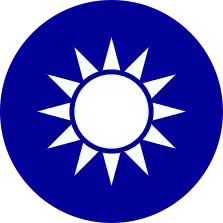Taiwan–United States relations
Taiwan–United States relations, also known as Taiwanese–American relations and historically Sino–American relations, refers to international relations between the Republic of China (ROC), commonly known as Taiwan, and the United States of America. The bilateral relationship between the two states is the subject of China–United States relations before the government led by the Kuomintang (Chinese Nationalist Party) retreated to Taiwan and its neighboring islands as a result of the Chinese Civil War and until the U.S. ceased recognizing the ROC in 1979 as "China" and started referring to it as "Taiwan". Prior to relations with the ROC, the United States had diplomatic relations with the Qing dynasty beginning on June 16, 1844 until 1912.[1]
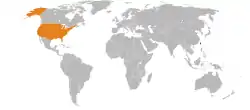 | |
Taiwan |
United States |
|---|---|
| Diplomatic mission | |
| Taipei Economic and Cultural Representative Office in the United States | American Institute in Taiwan |
| Envoy | |
| Representative Hsiao Bi-khim | AIT Director Brent Christensen |
| Taiwan- United States relations | |||||||||||||
|---|---|---|---|---|---|---|---|---|---|---|---|---|---|
.jpg.webp) ROC Defense Mission to the United States. | |||||||||||||
| Traditional Chinese | 臺灣與美國關係 | ||||||||||||
| Simplified Chinese | 台湾与美国关系 | ||||||||||||
| |||||||||||||
| Republic of China - United States relations | |||||||||||||
| Traditional Chinese | 中華民國與美國關係 | ||||||||||||
| Simplified Chinese | 中华民国与美国关系 | ||||||||||||
| |||||||||||||
After the United States established diplomatic relations with the Beijing government, or People's Republic of China (PRC), under the Communist Party of China's rule as "China" in 1979, Taiwan–United States relations became unofficial and informal. Until March 16, 2018, informal relations between the two states were governed by the U.S. Taiwan Relations Act (TRA), which allows the United States to have relations with the "people on Taiwan" and their government, whose name is not specified. U.S.–Taiwan relations were further informally grounded in the "Six Assurances" in response to the third communiqué on the establishment of US–PRC relations. Following the passage of the Taiwan Travel Act by the U.S. Congress on March 16, 2018, relations between the United States and Taiwan have since maneuvered to an official and high-level basis.[2] Both sides have since signed a consular agreement formalizing their existent consular relations on September 13, 2019.[3] The United States removed self-imposed restrictions on executive branch contacts with Taiwan on January 9, 2021.[4]
The policy of deliberate ambiguity of US foreign policy to Taiwan is important to stabilize cross-strait relations and to assist Taiwan from an invasion by the PRC if possible, whereas a policy of strategic clarity on Taiwan would likely induce PRC opposition and challenges to US legitimacy in East Asia or beyond.[5][6][7] As stipulated by the TRA, the United States continues to be the main provider of arms to Taiwan, which is often a source of tension with the PRC.[8] Both states maintain representative offices functioning as de facto embassies. Taiwan is represented by the Taipei Economic and Cultural Representative Office in the United States (TECRO), [9] and the United States by the American Institute in Taiwan (AIT).[10]
History
Taiwan under Qing & Japanese rule (Pre–1945)
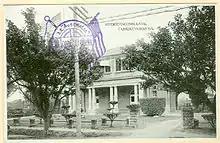
Two American diplomats in the 1850s suggested to Washington that the U.S. should obtain the island of Taiwan from China, but the idea was rejected.[11][12] Aboriginals on Taiwan often attacked and massacred shipwrecked western sailors, and American diplomats tried to help them.[13] In 1867, during the Rover incident, Taiwanese aborigines attacked shipwrecked American sailors, killing the entire crew. They subsequently skirmished against and defeated a retaliatory expedition by the American military and killed another American during the battle.[14]
In the Japanese era, the United States also hosted a consulate in Taihoku, Formosa (today Taipei) from 1913. The consulate was closed in 1941 due to United States declaration of war on Japan. The site is now protected as the Former American Consulate in Taipei.
ROC on Taiwan
Beiyang and Nationalist era
In 1784, the United States attempted to send a consul to China, but this was rejected by the Chinese government, with official relations beginning on June 16, 1844 under President John Tyler,[1] leading to the 1845 Treaty of Wangxia.
As Taiwan was under Japanese control, following the Xinhai Revolution in 1911, which overthrew the Qing dynasty, the William Taft administration recognized the government of the Republic of China (ROC) as the sole and legitimate government of China despite a number of governments ruling various parts of China. China was reunified by a single government, led by the Kuomintang (KMT) in 1928, which subsequently gained recognition as China's only legitimate government despite continued internal strife. The first winner of the Nobel Prize in Literature for writing about China was an American, born in the United States but raised in China, Pearl S. Buck, whose 1938 Nobel lecture was titled The Chinese Novel.[15]
During the Pacific War, the United States and the Republic of China were allied against Japan. In October 1945, a month after Japan's surrender, representatives of Chiang Kai-shek, on behalf of the Allies, were sent to Formosa to accept the surrender of Japanese troops. However, during the period of the 1940s, there was no recognition by the United States Government that Taiwan had ever been incorporated into Chinese national territory.[16] Chiang continued to remain suspicious of America's motives.[17]
Retreat to Taiwan
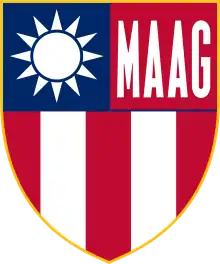
.svg.png.webp)
.jpg.webp)
As the Korean War broke out, the Truman Administration resumed economic and military aid to the ROC on Taiwan and neutralized the Taiwan Strait by United States Seventh Fleet to stop a Communist invasion of Formosa[18] (as well as a potential ROC counter-invasion of the mainland).[19] US military presence in Taiwan consisted of the Military Assistance Advisory Group (MAAG) and the United States Taiwan Defense Command (USTDC). Other notable units included the 327th Air Division. Until the US formally recognized the People's Republic of China in 1979, Washington provided ROC with financial grants based on the Foreign Assistance Act,[20] Mutual Security Act and Act for International Development enacted by the US Congress. A separate Sino-American Mutual Defense Treaty was signed between the two governments of US and ROC in 1954 and lasted until 1979.
The U.S. State Department's official position in 1959 was:
- That the provisional capital of the Republic of China has been at Taipei, Taiwan (Formosa) since December 1949; that the Government of the Republic of China exercises authority over the island; that the sovereignty of Formosa has not been transferred to China; and that Formosa is not a part of China as a country, at least not as yet, and not until and unless appropriate treaties are hereafter entered into. Formosa may be said to be a territory or an area occupied and administered by the Government of the Republic of China, but is not officially recognized as being a part of the Republic of China.[21]
Since 1979
.jpg.webp)
At the height of the Sino-Soviet Split, and at the start of the reform and opening of People's Republic of China, the United States strategically switched diplomatic recognition from the Republic of China (ROC) to the People's Republic of China (PRC) on January 1, 1979 to counter the political influences and military threats from the Soviet Union. The US Embassy in Taipei was 'migrated' to Beijing and the Taiwanese Embassy in the US was closed. Following the termination of diplomatic relations, the United States terminated its Mutual Defense Treaty with Taiwan on January 1, 1980.
On April 10, 1979, U.S. President Jimmy Carter signed into law the Taiwan Relations Act (TRA), which created domestic legal authority for the conduct of unofficial relations with Taiwan. U.S. commercial, cultural, and other interaction with the people on Taiwan is facilitated through the American Institute in Taiwan (AIT), a private nonprofit corporation. The institute has its headquarters in the Washington, DC area and has offices in Taipei and Kaohsiung. It is authorized to issue visas, accept passport applications, and provide assistance to U.S. citizens in Taiwan. A counterpart organization, the Taipei Economic and Cultural Representative Office in the United States (TECRO), has been established by Taiwan. It has its headquarters in Taipei, the representative branch office in Washington, DC, and 11 other Taipei Economic and Cultural Offices (TECO) in the continental U.S. and Guam. The Taiwan Relations Act (TRA) continues to provide the legal basis for the unofficial relationship between the U.S. and Taiwan, and enshrines the U.S. commitment to assisting Taiwan maintain its defensive capability.
In July 2002, Minister of Justice Chen Ding-nan (陳定南) became the first Taiwanese government official to be invited into the White House after the US had de-recognized Taiwan.
After de-recognition, the U.S. still maintains unofficial diplomatic relations with Taiwan through Taipei Economic and Cultural Representative Office; the current head of TECRO in Washington, D.C. is Stanley Kao. The American Institute in Taiwan, a non-profit institute headquarters in the US soil under the laws of the District of Columbia in Arlington County, Virginia and serves as the semi-official, working-level US representation and AIT has branch offices in Taipei and Kaohsiung. The Chairman of AIT is Raymond Burghardt. Christopher J. Marut was appointed to be the new AIT Taipei Office Director in August 2012.[22][23] With the absence of diplomatic recognition, in the present state, Taiwan-US relations are formally guided by the service of enactment of Taiwan Relations Act by US Congress for the continuation of Taiwan-US relations after 1979. In 2013, Taiwan Policy Act of 2013 was raised and passed in House Committee on Foreign Affairs by the US Congress to update the condition of US-Taiwan relations.[24][25] In 2015 Kin Moy was appointed to the Director of the AIT.
U.S. commercial ties with Taiwan have been maintained and have expanded since 1979. Taiwan continues to enjoy Export-Import Bank financing, Overseas Private Investment Corporation guarantees, normal trade relations (NTR) status, and ready access to U.S. markets. In recent years, AIT commercial dealings with Taiwan have focused on expanding market access for American goods and services. AIT has been engaged in a series of trade discussions, which have focused on copyright concerns and market access for U.S. goods and services.
On December 16, 2015, the Obama administration announced a deal to sell $1.83 billion worth of arms to the Armed Forces of Taiwan, a year and eight months after U.S. House passed the Taiwan Relations Act Affirmation and Naval Vessel Transfer Act of 2014 to allow the sale of Oliver Hazard Perry-class frigates to Taiwan. The deal would include the sale of two decommissioned U.S. Navy frigates, anti-tank missiles, Assault Amphibious Vehicles, and FIM-92 Stinger surface-to-air missiles, amid the territorial disputes in the South China Sea.[26][27] China's foreign ministry had expressed its disapproval for the sales and issued the U.S. a "stern warning", saying it would hurt China–U.S. relations.[28]
A new $250 million compound for the American Institute in Taiwan was unveiled in June 2018, accompanied by a "low-key" American delegation.[29] The Chinese authorities estimated this action as violation of "one China" policy statement and claimed the US to stop any relations with Taiwan without approbation of China.
In September 2018, the United States approved the sale of $330 million worth of spare parts and other equipment to sustain the Republic of China Air Force.[30][31]
In July 2019, the US State Department approved the sale of M1A2T Abrams tanks, Stinger missiles and related equipment at an approximate value of $2.2 billion to Taiwan.[32]
In May 2020, the US State Department approved a possible Foreign Military Sale of 18 MK-48 Mod 6 Advanced Technology Heavy Weight Torpedoes for Taiwan in a deal estimated to cost $180 million.[33]
On 9 August 2020, U.S. Health and Human Services Secretary Alex Azar visited Taiwan to meet President Tsai Ing-wen, the first visit by an American official since the break in diplomatic relations between Washington and Taipei in 1979.[34] In September 2020, U.S. Under Secretary of State for Economic Growth, Energy, and the Environment Keith J. Krach attended the memorial service for former Taiwanese President Lee Teng-hui.[35]
In an October 2020 deal of $2.37 billion between the U.S and Taiwan, the U.S. State Department approved the potential sale to Taiwan of 400 anti-ship cruise missiles including associated radars, road-mobile launchers, and technical support.[36]
Notable issues
In 1949, when Generalissimo Chiang Kai-shek's troops decamped to Taiwan at the end of the Chinese civil war, Washington continued to recognize Chiang's "Republic of China" as the government of all China. In late 1978, Washington announced that it would break relations with the government in Taipei and formally recognize the People's Republic of China (PRC) as the "sole legal government of China."[37]
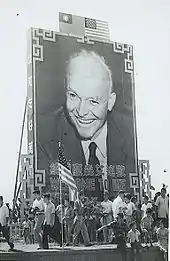
Washington's "one China" policy, however, does not mean that the United States recognizes, nor agrees with Beijing's claims to sovereignty over Taiwan.[37][38] On July 14, 1982 the Republican Reagan Administration gave specific assurances to Taiwan that the United States did not accept China's claim to sovereignty over the island (Six Assurances),[37][39] and the U.S. Department of State informed the Senate that "[t]he United States takes no position on the question of Taiwan's sovereignty."
The U.S. Department of State, in its U.S. Relations With Taiwan fact sheet, states "[T]he United States and Taiwan enjoy a robust unofficial relationship. The 1979 U.S.–P.R.C. Joint Communiqué switched diplomatic recognition from Taipei to Beijing. In the Joint Communiqué, the United States recognized the Government of the People's Republic of China as the sole legal government of China, acknowledging the Chinese position that there is but one China and Taiwan is part of China.[40]
The United States position on Taiwan is reflected in "the six assurances to Taiwan", the Three Communiqués, and the Taiwan Relations Act (TRA).[41] The Six Assurances include: 1. The United States has not agreed to set a date for ending arms sales to Taiwan; 2. The United States has not agreed to hold prior consultations with the Chinese on arms sales to Taiwan; 3. The United States would not play any mediation role between Taiwan and Beijing; 4. The United States has not agreed to revise the Taiwan Relations Act; 5. The United States has not altered its position regarding sovereignty over Taiwan; and 6. The United States would not exert pressure on Taiwan to enter into negotiations with the Chinese.[42] The "Three Communiqués" include The Shanghai Communiqué, The Normalisation Communiqué, and The August 17 Communiqué, which pledged to abrogate official US-ROC relations, remove US troops from Taiwan and gradually end the arms sale to Taiwan, but with the latter of no timeline to do so, an effort made by James Lilley, the Director of American Institute in Taiwan.
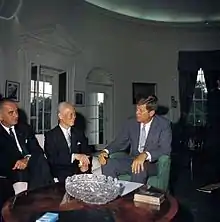
Despite friendly relations with China, United States President George W. Bush was asked on 25 April 2001, "if Taiwan were attacked by China, do we (The U.S.) have an obligation to defend the Taiwanese?" He responded, "Yes, we do...and the Chinese must understand that. The United States would do whatever it took to help Taiwan defend herself."[43] He made it understood that "though we (China and the U.S.) have common interests, the Chinese must understand that there will be some areas where we disagree."[43]
.jpg.webp)
On 19 June 2013, ROC Ministry of Foreign Affairs expressed gratitude for a US Congress's bill in support of Taiwan's bid to participate in the International Civil Aviation Organization (ICAO).[44] On July 12, 2013, US President Barack Obama signed into law H.R. 1151, codifying the US government's full support for Taiwan's participation in the ICAO as a non-sovereign entity.[45] The United States has continued the sale of appropriate defensive military equipment to Taiwan in accordance with the Taiwan Relations Act, which provides for such sales and which declares that peace and stability in the area are in U.S. interests. Sales of defensive military equipment are also consistent with the 1982 U.S.-P.R.C. Joint Communiqué.
Maintaining diplomatic relations with the PRC has been recognised to be in the long-term interest of the United States by seven consecutive administrations; however, maintaining strong, unofficial relations with Taiwan is also a major U.S. goal, in line with its desire to further peace and stability in Asia. In keeping with its China policy, the U.S. does not support de jure Taiwan independence, but it does support Taiwan's membership in appropriate international organisations, such as the World Trade Organization, Asia-Pacific Economic Cooperation (APEC) forum, and the Asian Development Bank, where statehood is not a requirement for membership. In addition, the U.S. supports appropriate opportunities for Taiwan's voice to be heard in organisations where its membership is not possible.
On 24 August 2010, the United States State Department announced a change to commercial sales of military equipment in place of the previous foreign military sales in the hope of avoiding political implications.[46] However pressure from the PRC has continued and it seems unlikely that Taiwan will be provided with advanced submarines or jet fighters.[47]
Taiwan has indicated that it is willing to host national missile defense radars to be tied into the American system, but is unwilling to pay for any further cost overruns in the systems.[48]
.jpg.webp)
On December 2, 2016, U.S. President-Elect Donald Trump accepted a congratulatory call from Taiwanese President Tsai Ing-Wen, which was the first time since 1979 that a President-Elect has publicly spoken to a leader of Taiwan.[49] Donald Trump stated the call was regarding "the close economic, political and security ties between Taiwan and the US".[50] The phone call had been arranged by Bob Dole, who acted as a foreign agent on behalf of Taiwan.[51]
PRC Foreign Minister Wang Yi soon made a statement saying that China opposes any move to separate the country, without explicitly mentioning the phone call between Tsai and Trump.
On 16 March 2018, President Trump signed the Taiwan Travel Act,[52] allowing high-level diplomatic engagement between Taiwanese and American officials, and encourages visits between government officials of the United States and Taiwan at all levels.[53][54] The legislation has sparked outrage from the PRC,[55] and has been applauded by Taiwan.[56][53]
On 17 July 2018, Taiwan's Army was officially commissioned all of its Apache attack helicopters purchased from the United States, at cost of $59.31 billion NT(US$1.94 billion), having completed the necessary pilot training and verification of the fleet's combat capability. One of the helicopters was destroyed in a crash during a training flight in Taoyuan in April 2014 and the other 29 have been allocated to the command's 601st Brigade, which is based in Longtan, Taoyuan. Taiwanese President Tsai Ing-wen said the commissioning of the Apaches was "an important milestone" in meeting the island's "multiple deterrence" strategy to counter an invasion and to resist Beijing's pressure with support from Washington, which has been concerned about Beijing's growing military expansion in the South China Sea and beyond.[57]
On 26 March 2020, President Trump signed the TAIPEI Act, aiming to increase the scope of US relations with Taiwan and encouraging other nations and international organizations to strengthen their official and unofficial ties with the island nation.[58]
Consular Representation
The United States operates a de-facto embassy in Taipei called the American Institute in Taiwan. It operates a consulate in Kaohsiung called the American Institute in Taiwan Kaohsiung Branch Office.
Taiwan operates several diplomatic missions in the United States, with the Taipei Economic and Cultural Representative Office in the United States located in Washington, D.C. This mission is also accredited to Cuba, the Bahamas, Grenada, Antigua and Barbuda, Dominica, and Trinidad and Tobago, despite Taiwan not having offical relations with them. Other than the mission in Washington, Taiwan also operates consulates in Atlanta, Boston, Chicago, Honolulu, Houston, Miami, Los Angeles, New York, San Francisco, Seattle, and Denver.[59] Taiwan formerly operated a consulate in Guam.
See also
References
- "A GUIDE TO THE UNITED STATES' HISTORY OF RECOGNITION, DIPLOMATIC, AND CONSULAR RELATIONS, BY COUNTRY, SINCE 1776: CHINA". history.state.gov. U.S. Department of State. Retrieved May 2, 2015.
Mutual Recognition, 1844. Formal recognition by the United States of the Empire of China, and by the Empire of China of the United States, came on or about June 16, 1844, when U.S. Envoy Extraordinary and Minister Plenipotentiary Caleb Cushing presented his credentials and met with Chinese official Qiying to discuss treaty negotiations. Prior to this, the United States had dispatched consuls to Guangzhou as early as 1784—the first was Samuel Shaw, the supercargo on the Empress of China—but these had never been formally received by Chinese officials as state representatives. The two countries had acknowledged each other's existence before 1844, but the negotiations and treaty of that year marked the first recognition under international law.
- Steve, Chabot (March 16, 2018). "H.R.535 - 115th Congress (2017-2018): Taiwan Travel Act". Congress.gov. Retrieved April 4, 2018.
- "US and Taiwan strengthen ties by signing agreement to formalize consular functions". Stars and Strips. October 7, 2019.
- Pompeo, Michael. "Lifting Self-Imposed Restrictions on the U.S.-Taiwan Relationship". U.S. Department of State. U.S. Government. Retrieved January 9, 2021.
- "Thesis". repository.library.georgetown.edu.
- "Foreign Press Centers" (PDF). fpc.state.gov.
- Benson, Brett; Niou, Emerson (April 7, 2000). "Comprehending strategic ambiguity: US policy toward the Taiwan Strait security issue" – via ResearchGate. Cite journal requires
|journal=(help) - "Taiwan Set to Receive $2 Billion in U.S. Arms, Drawing Ire From China". The New York Times. July 9, 2019.
- "Taipei Economic and Cultural Representative Office in the United States".
- "American Institute in Taiwan".
- Leonard H. D. Gordon (2009). Confrontation Over Taiwan: Nineteenth-Century China and the Powers. Lexington Books. pp. 32–. ISBN 978-0-7391-1869-6.
- Leonard Gordon, "Early American Relations with Formosa, 1849–1870." Historian 19.3 (1957): 262-289 at pp 271-77.
- Leonard Gordon, "Early American Relations with Formosa, 1849–1870." at pp 264-68.
- The Nation. 1889. pp. 256–57.
- Pearl S. Buck (1938), The Chinese Novel: Lecture Delivered before the Swedish Academy at Stockholm, December 12, 1938, by Pearl S. Buck.
- "Plebiscite Proposal". Retrieved December 12, 2009.
- Fenby, Jonathan (2005). Chiang Kai Shek: China's Generalissimo and the Nation He Lost. Carroll & Graf Publishers. p. 413. ISBN 0-7867-1484-0. Retrieved June 28, 2010.
- "The Chinese Revolution of 1949". history.state.gov. Retrieved November 23, 2018.
- "Taiwan's plan to take back mainland". BBC News. September 7, 2009. Retrieved November 23, 2018.
- "Archived copy". Archived from the original on February 17, 2007. Retrieved April 3, 2013.CS1 maint: archived copy as title (link)
- Frank Chiang (2017). The One-China Policy: State, Sovereignty, and Taiwan's International Legal Status. Elsevier Science. p. 229. ISBN 9780081023150.
- "American Institute in Taiwan".
- "Archived copy". Archived from the original on February 19, 2014. Retrieved June 29, 2012.CS1 maint: archived copy as title (link)
- "H.R. 419, Taiwan Policy Act of 2013".
- "HR 419" (PDF). GPO.gov.
- "US to sell arms to Taiwan despite Chinese opposition". BBC News. December 16, 2015. Retrieved December 17, 2015.
- "Obama to push ahead on Taiwan frigate sales despite Chinese anger". CNBC. Reuters. December 14, 2015. Retrieved December 17, 2015.
- "China warns against first major US-Taiwan arms sale in four years". The Guardian. Reuters. December 16, 2015. Retrieved December 17, 2015.
- Horton, Chris (June 12, 2018). "U.S. Unveils an Office in Taiwan, but Sends No Top Officials". The New York Times.
- Waldron, Greg (September 25, 2018). "USA approves support package for Taiwan air force". FlightGlobal. Singapore. Archived from the original on September 25, 2018. Retrieved September 25, 2018.
- "Taipei Economic and Cultural Representative Office in the United States (TECRO) – Foreign Military Sales Order (FMSO) II Case". United States Defense Security Cooperation Agency. Washington: United States Department of Defense. September 24, 2018. Archived from the original on September 25, 2018. Retrieved September 25, 2018.
- "U.S. State Department approves possible $2.2 billion arms sale to Taiwan". Reuters. Retrieved July 8, 2019.
- Defense Security Cooperation Agency. "Taipei Economic and Cultural Representative Office in the United States (tecro) – MK 48 Mod 6 Advanced Technology (at) Heavy Weight Torpedo (HWT)". DSCA. Archived from the original on September 22, 2020. Retrieved September 22, 2020.
- "US Health and Human Services Secretary Visits Taiwan". VOA News. August 9, 2020.
- "US sending State Department official Keith Krach to Taiwan for Lee Teng-hui memorial service". South China Morning Post. September 17, 2020.
- Larter, David (October 26, 2020). "U.S. State Department to allow sale of hundreds of anti-ship missiles to Taiwan amid diplomatic row". Defense News. Retrieved October 28, 2020.
- "Stating America's Case to China's Hu Jintao: A Primer on U.S.-China-Taiwan Policy". The Heritage Foundation.
- "Stating America's Case to China's Hu Jintao: A Primer on U.S.-China-Taiwan Policy". The Heritage Foundation.
- For a detailed description of the U.S. "one China" stance, see Ambassador Harvey Feldman, "A Primer on U.S. Policy Toward the 'One-China' Issue: Questions and Answers," Heritage Foundation Backgrounder No. 1429, April 12, 2001.
- "Taiwan".
- "Stating America's Case to China's Hu Jintao: A Primer on U.S.-China-Taiwan Policy". The Heritage Foundation.
- Testimony of John H. Holdridge, Assistant Secretary of State for East Asian Affairs, in hearing, China-Taiwan: United States Policy, Committee on Foreign Affairs, U.S. House of Representatives, 97th Cong., 2nd Sess., August 18, 1982, pp. 15-16. Holdridge described the Six Assurances in his memoir, Crossing the Divide, p. 232.
- "Archived copy". Archived from the original on November 10, 2003. Retrieved June 1, 2014.CS1 maint: archived copy as title (link)
- "Taiwan grateful for U.S. House support for ICAO bid".
- "US passes law supporting Taiwan ICAO bid". July 14, 2013.
- ROC Central News Agency U.S. arms sales to return to normal track: Taiwan official
- Waldron, Greg. "Outlook gloomy for Taiwan F-16 C/D deal." Flight International, May 26, 2011.
- "Taiwan rejects further advanced radar system price hikes." CNA, June 14, 2011.
- "Trump risks showdown with China after call with Taiwan". CNN. December 2, 2016. Retrieved December 3, 2016.
- "Trump speaks with Taiwanese president, a major break with decades of U.S. policy on China". Washington Post.
- "Bob Dole Worked Behind the Scenes on Trump-Taiwan Call". New York Times.
- van der Wees, Gerrit (March 19, 2018). "The Taiwan Travel Act in Context". thediplomat.com. The Diplomat. Retrieved June 4, 2018.
- "U.S. president signs Taiwan Travel Act despite warnings from China - Politics - FocusTaiwan Mobile - CNA English News".
- "Donald Trump signs Taiwan Travel Act, drawing China's ire - DW - 17.03.2018". DW.COM.
- "China urges US to 'correct mistake' on Taiwan rules - Taipei Times". Taipeitimes.com. March 19, 2018.
- "Beijing 'strongly dissatisfied' as Trump signs Taiwan Travel Act". March 17, 2018.
- Lawrence Chung (July 17, 2018). "Taiwan puts second squad of US Apache attack helicopters on duty as Beijing boosts military presence". South China Morning Post.
- Hsu, Stacy; Huang, Frances; Chen, Christie; Lin, Ko (March 27, 2020). "Trump signs TAIPEI Act into law". Central News Agency. Retrieved March 29, 2020.
- 台灣指南. "美洲". 台灣指南. Retrieved December 9, 2019.
Further reading
| Library resources about Taiwan–United States relations |
- Benson, Brett V., and Emerson MS Niou. "Public opinion, foreign policy, and the security balance in the Taiwan Strait." Security Studies 14.2 (2005): 274–289.
- Bush, Richard C. At cross purposes: US-Taiwan relations since 1942 (Routledge, 2015).
- Carpenter, Ted Galen. America's coming war with China: a collision course over Taiwan (Macmillan, 2015).
- Glaser, Charles L. "A US-China grand bargain? The hard choice between military competition and accommodation." International Security 39#4 (2015): 49–90.
- Hickey, Dennis Van Vranken. "America's Two-point Policy and the Future of Taiwan." Asian Survey (1988): 881–896. in JSTOR
- Hickey, Dennis V. "Parallel Progress: US-Taiwan Relations During an Era of Cross-Strait Rapprochement." Journal of Chinese Political Science 20#4 (2015): 369–384.
- Hu, Shaohua. "A Framework for Analysis of National Interest: United States Policy toward Taiwan," Contemporary Security Policy, Vol. 37, No. 1 (April 2016): 144–167.
- Kim, Claudia J. (2019) "Military alliances as a stabilising force: U.S. relations with South Korea and Taiwan, 1950s-1960s." Journal of Strategic Studies
- Liao, Nien-chung Chang, and Dalton Kuen-da Lin. "Rebalancing Taiwan–US Relations." Survival 57#6 (2015): 145–158. online
- Ling, Lily HM, Ching-Chane Hwang, and Boyu Chen. "Subaltern straits:‘exit’,‘voice’, and ‘loyalty’in the United States–China–Taiwan relations." International Relations of the Asia-Pacific (2009): lcp013.
- Peraino, Kevin. A Force So Swift: Mao, Truman, and the Birth of Modern China, 1949 (2017), focus on .S. policy in 1949
External links
- Taiwan-US Relations from the Dean Peter Krogh Foreign Affairs Digital Archives
- Mandatory Guidance from Department of State Regarding Contact with Taiwan
- U.S. Relations With Taiwan
- Taiwan - US Relations from the Dean Peter Krogh Foreign Affairs Digital Archives
- Stating America's Case to China's Hu Jintao: A Primer on U.S.-China-Taiwan Policy
![]() This article incorporates public domain material from the United States Department of State website https://www.state.gov/countries-areas/. (U.S. Bilateral Relations Fact Sheets)
This article incorporates public domain material from the United States Department of State website https://www.state.gov/countries-areas/. (U.S. Bilateral Relations Fact Sheets)
